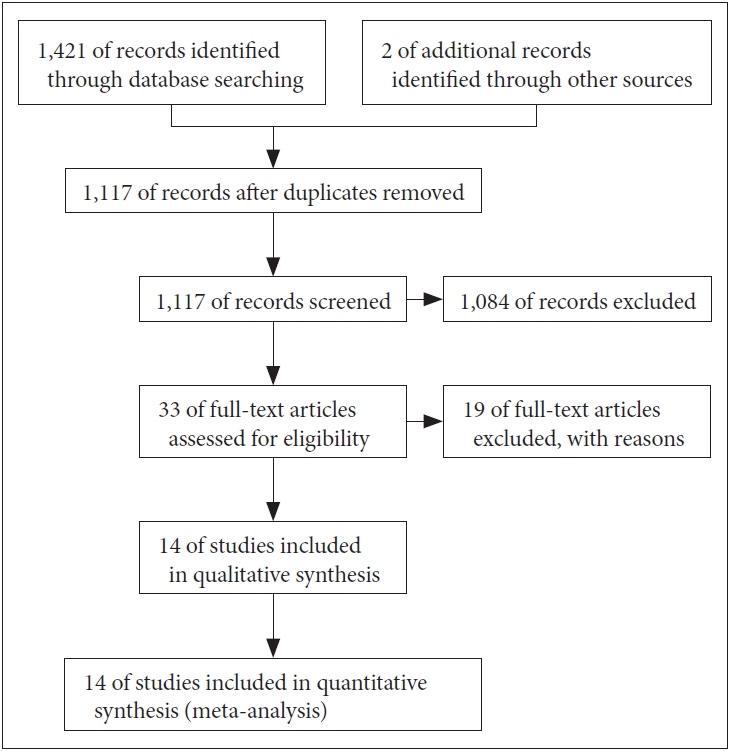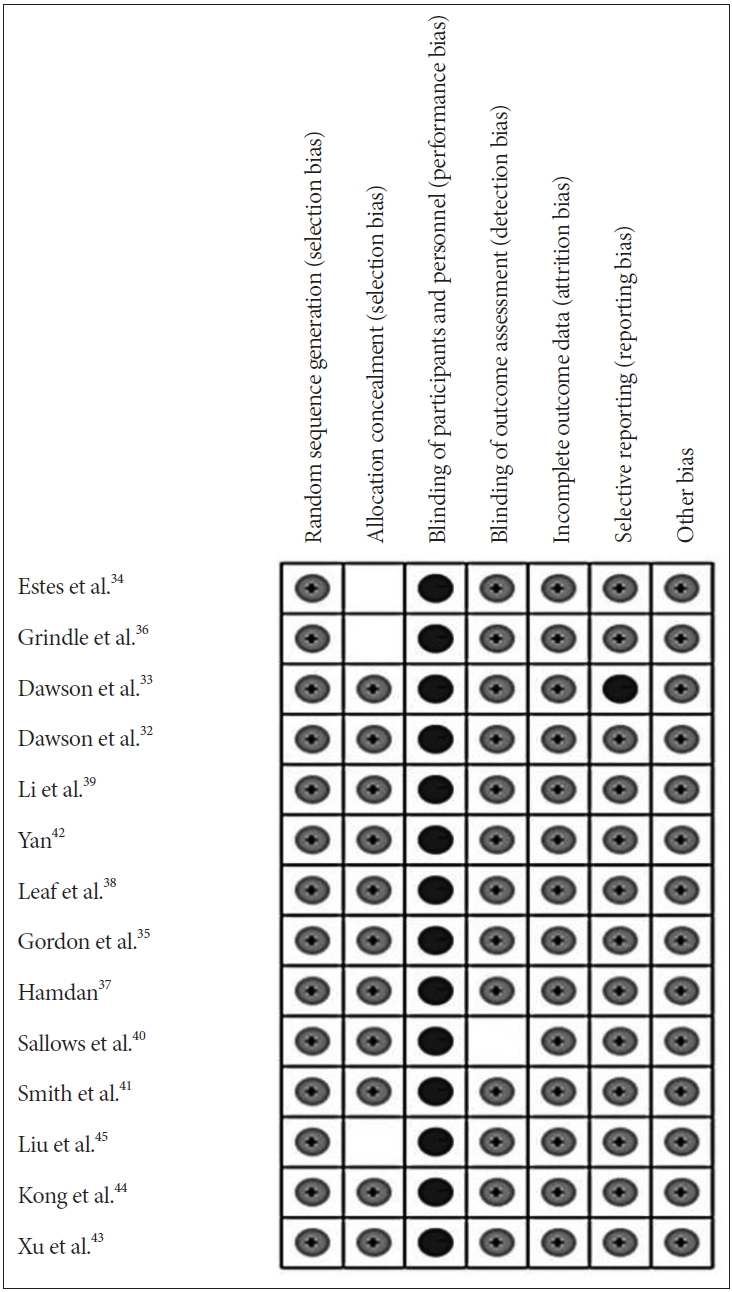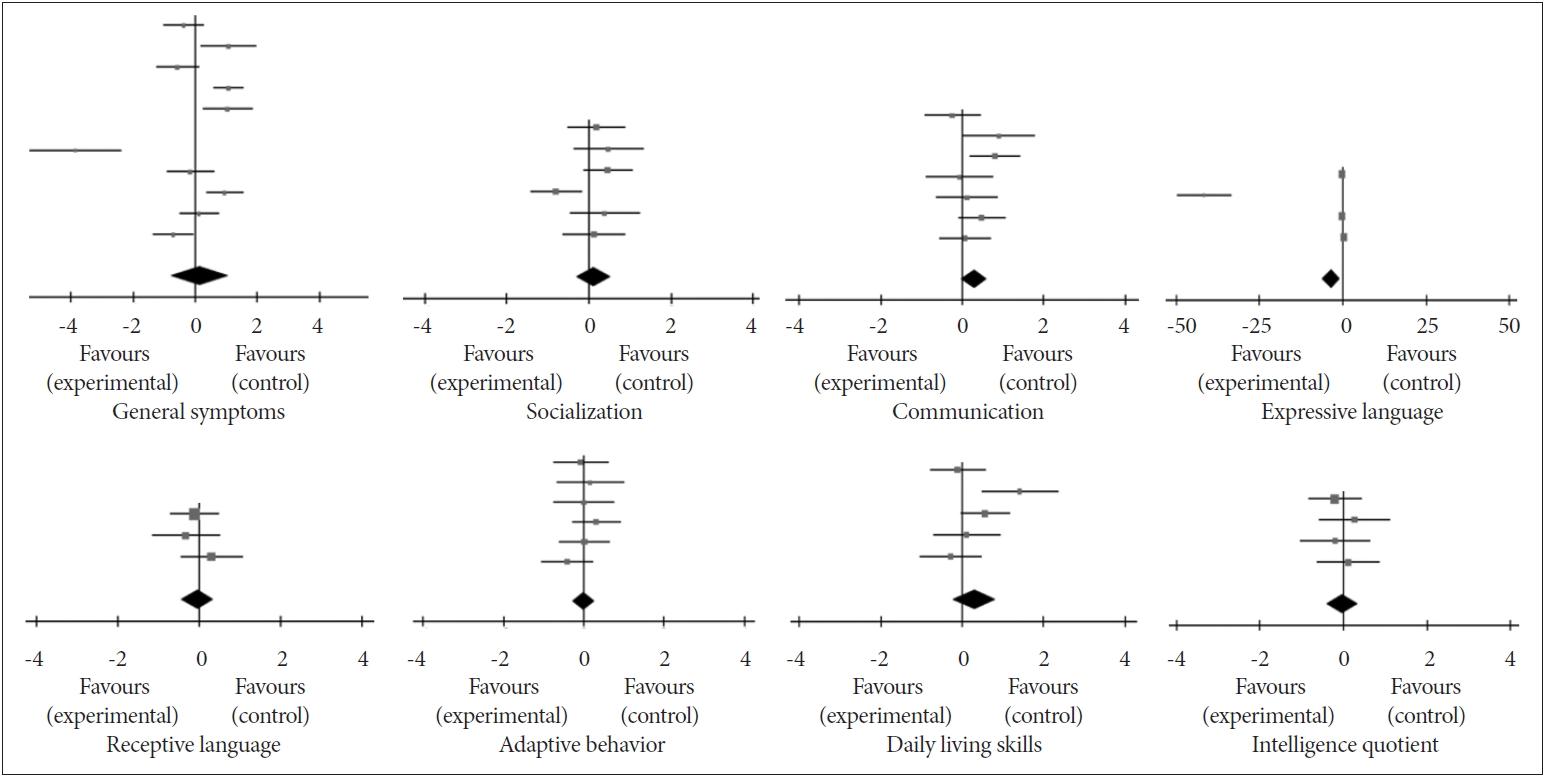 |
 |
- Search
| Psychiatry Investig > Volume 17(5); 2020 > Article |
|
Abstract
Objective
Methods
Results
ACKNOWLEDGEMENTS
The authors have no potential conflicts of interest to disclose.
Author Contributions
Conceptualization: Qian Yu. Data curation: Enyao Li, Liguo Li, Weiyi Liang. Formal analysis: Weiyi Liang. Investigation: Weiyi Liang. Methodology: Qian Yu. Project administration: Qian Yu. Resources: Qian Yu. Software: Weiyi Liang. Supervision: Qian Yu. Validation: Qian Yu. Visualization: Qian Yu. Writing—original draft: Weiyi Liang, Qian Yu. Writing—review & editing: Qian Yu.
Table 1.
| Study | Exp. (N) | Cont. (N) | Age (months) | Type of Exp. | Exp. dosage | Exp. administrator | Caregiver involvement | Location | Outcome measurement |
|---|---|---|---|---|---|---|---|---|---|
| Dawson et al. [32] | 48 | 21 | 54.1 | ESDM | 2 h each time, twice a day, 5 days a week, for 2 years | Trained therapists | Parents used ESDM strategies during daily activities | Center | ADI-R, ADOS, MSEL, PDD-BI, VABS |
| Dawson et al. [33] | 39 | 21 | 23.9 | ESDM | 2 h per session, twice a day, 5 days per week, for 2 years | Trained therapists | Parent gave family intervention above 5 hours per week | Center | ADI-R, ADOS, MSEL, VABS, RBS |
| Estes et al. [34] | 39 | 21 | 24 | ESDM | A high level of intensity, for 2 years | Parents | Children only got in-home intervention | Home | DAS, VABS, ADOS, ABC, ADI-R |
| Gordon et al. [35] | 26 | 28 | 81.6 | PECS | Once a day, for 9 months | Teachers | No involvement | Elementary school | ADOS, COSMIC, Videotaped observation |
| Grindle et al. [36] | 11 | 18 | 58.2 | ABA | 6 h each day, 5 days per week, for 2 years | Therapists | Generalization of acquired skills at home | Mainstream school | SBIS-4, LIPS-R, VABS, ABLLS, ABLLS-R |
| Hamdan [37] | 13 | 13 | 102.0 | DTT | 35 min per session, 3 sessions a week, for 12 weeks | Teacher students | No involvement | Institution | NVCSS |
| Leaf et al. [38] | 8 | 7 | 6.0 | ABA | 2 h per session, 32 sessions in total | Teachers | No involvement | Kindergarten | GARS-2, SSIS, SRS, WM, ABC, SVS |
| Li et al. [39] | 17 | 18 | 38.0 | ESDM | 2 h a session, 1 session per day, 6 days a week, for 12 weeks | Teachers | 2-h ESDM intervention at home per day | Department of developmental-behavioral pediatrics in hospital | ABC, CARS, CGI-S |
| Sallows et al. [40] | 13 | 10 | 33.0 | ABA | 39 h a week in year 1 | Therapists | Weekly supervision at home | School | VABS |
| 37 h a week in year 2 | |||||||||
| Smith et al. [41] | 15 | 13 | 36.0 | ABA | 30 h a week, for 2-3 years | Student therapists | Cooperation with home visit and group visit | School | SBIS, RDLS, VABS, ACBQ WIAT, ELM, FSQ |
| Yan [42] | 42 | 42 | 38.0 | ABA | 30-40 h a week, for 6 months | Therapist | No involvement | Hospital | ATEC, C-PEP, ASSS, PedsQLTM, ABC |
| Xu et al. [43] | 16 | 20 | 47.5 | ESDM | 30 min a session, 2 sessions a day, 5 days a week, for 8 weeks | Teachers | No involvement | Center | CARS |
| Kong et al. [44] | 20 | 20 | 54.0 | PECS | 30 min a session, 1 session a day, 5 days a week, for 6 months | Therapists | Cooperation with therapists on PECS | Department of developmental-behavioral pediatrics in hospital | C-PEP |
| Liu et al. [45] | 25 | 25 | 55.0 | PECS | 1 session a day, 5 days a week, for 6 months | Therapists | No involvement | Department of developmental-behavioral pediatrics in hospital | C-PEP |
Exp.: experimental group, Cont.: control group, ADI-R: Autism Diagnostic Interview-Revised, ADOS: Autism Diagnostic Observation Schedule, MSEL: Mullen Scales of Early Learning, PDD-BI: Pervasive Developmental Disorder-Behavioral Inventory, VABS: Vineland Adaptive Behavior Scales, RBS: Repetitive Behavior Scale, DAS: Differential Ability Scales, ABC: Aberrant Behavior Checklist, SBIS-4: Stanford-Binet Intelligence Scale-Fourth Edition, LIPS-R: Leiter International Performance Scale-Revised, ABLLS: Assessment of Basic Language and Learning Skills, ABLLS-R: Assessment of Basic Language and Learning Skills-Revised, NVCSS: Non-verbal Communication Skills Scale, GARS-2: Gilliam Autism Rating Scale-Second Edition, SSIS: Social Skills Improvement System, SRS: Social Responsiveness Scale, WM: Walker-McConnell Scale of Social Competence and School Adjustment, SVS: Social Validity Survey, CARS: Childhood Autism Rating Scale, CGI-S: Clinical Global Impression-Severity, RDLS: Reynell Developmental Language Scales, ACBC: Achenbach Child Behavior Checklist, WIAT: Wechsler Individualized Achievement Test, ELM: Early Learning Measure, FSQ: Family Satisfaction Questionnaire, ATEC: Autism Treatment Evaluation Checklist, C-PEP: Psychoeducational Profile, ASSS: Autism Social Skills Scale, PedsQLTM: Pediatric Quality of Life Inventory Measurement Model
REFERENCES










